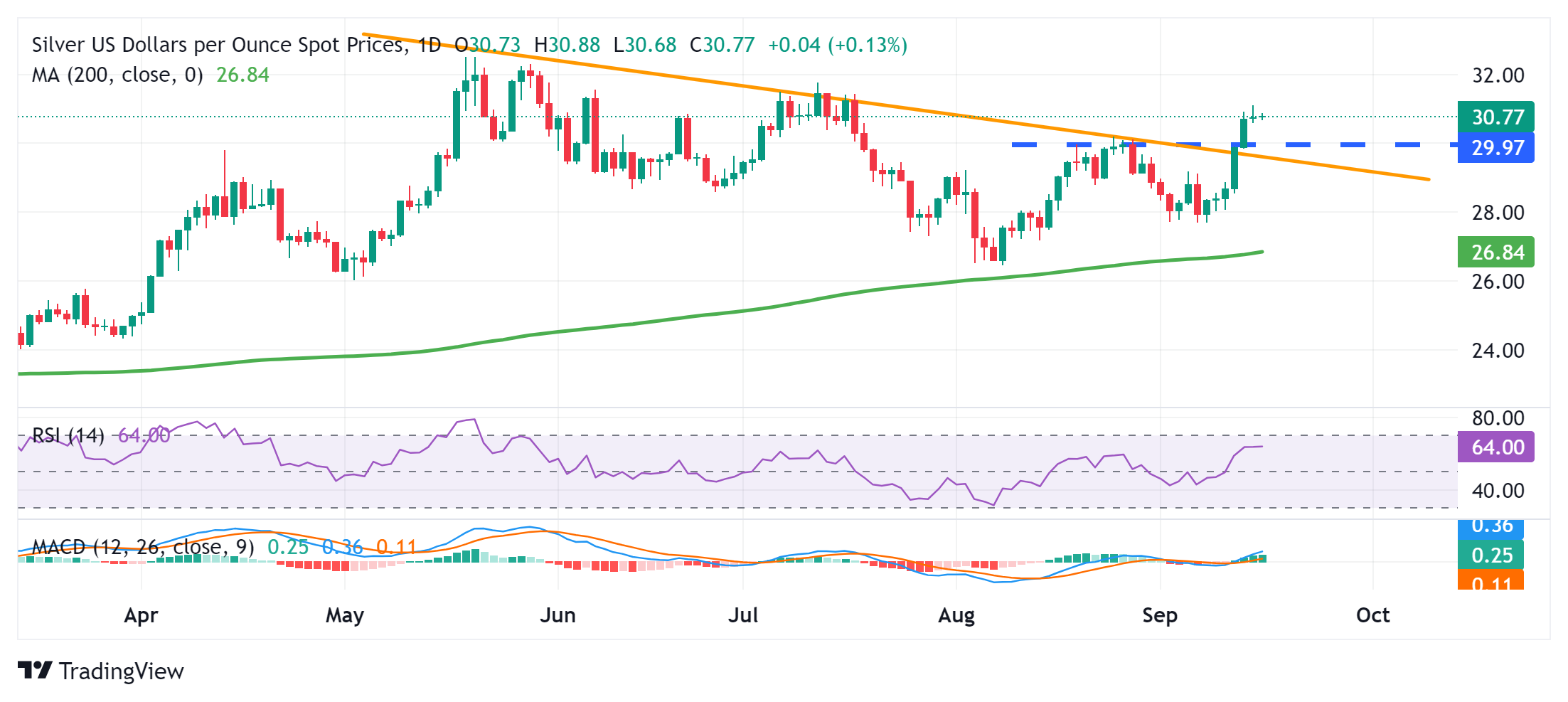Silver Price Forecast: XAG/USD consolidates below $31.00, bullish potential seems intact
- Silver struggles to gain any meaningful traction and oscillates in a range on Tuesday.
- The technical setup favors bullish traders and supports prospects for further gains.
- Any meaningful downfall could be seen as a buying opportunity and remain limited.
Silver (XAG/USD) trades with a positive bias around the $30.80-$30.85 area during the Asian session on Tuesday and remains well within the striking distance of a two-month peak touched the previous day.
From a technical perspective, Friday's convincing breakout through the $30.00 psychological mark barrier, which coincided with a short-term descending trend line, was seen as a fresh trigger for bullish traders. Moreover, oscillators on the daily chart have just started gaining positive traction and support prospects for a further near-term appreciating move for the XAG/USD.
Acceptance above the $31.00 mark will reaffirm the constructive outlook and lift the white metal to the next relevant hurdle near the $31.45-$31.50 supply zone. Some follow-through buying should allow bulls to aim back to reclaim the $32.00 mark. The momentum should allow the XAG/USD to aim back to challenge a one-decade high, around mid-$32.00s touched in May.
On the flip side, any meaningful corrective slide below the $30.50 immediate support is likely to attract fresh buyers and remain cushioned near the aforementioned descending trend-line resistance breakpoint, now turned support, near the $30.00 mark. The latter could act as a key pivotal point, which if broken might prompt some technical selling and make the XAG/USD vulnerable.
The subsequent fall could get extended towards the $29.40-$29.35 intermediate support en route to the $29.00 round figure. Some follow-through selling could drag the XAG/USD to the next relevant support near the $28.20-$28.15 zone. This is followed by the $28.00 mark and the monthly low, around the $27.70 area, which if broken might shift the bias back in favor of bearish traders.
XAG/USD daily chart
Silver FAQs
Silver is a precious metal highly traded among investors. It has been historically used as a store of value and a medium of exchange. Although less popular than Gold, traders may turn to Silver to diversify their investment portfolio, for its intrinsic value or as a potential hedge during high-inflation periods. Investors can buy physical Silver, in coins or in bars, or trade it through vehicles such as Exchange Traded Funds, which track its price on international markets.
Silver prices can move due to a wide range of factors. Geopolitical instability or fears of a deep recession can make Silver price escalate due to its safe-haven status, although to a lesser extent than Gold's. As a yieldless asset, Silver tends to rise with lower interest rates. Its moves also depend on how the US Dollar (USD) behaves as the asset is priced in dollars (XAG/USD). A strong Dollar tends to keep the price of Silver at bay, whereas a weaker Dollar is likely to propel prices up. Other factors such as investment demand, mining supply – Silver is much more abundant than Gold – and recycling rates can also affect prices.
Silver is widely used in industry, particularly in sectors such as electronics or solar energy, as it has one of the highest electric conductivity of all metals – more than Copper and Gold. A surge in demand can increase prices, while a decline tends to lower them. Dynamics in the US, Chinese and Indian economies can also contribute to price swings: for the US and particularly China, their big industrial sectors use Silver in various processes; in India, consumers’ demand for the precious metal for jewellery also plays a key role in setting prices.
Silver prices tend to follow Gold's moves. When Gold prices rise, Silver typically follows suit, as their status as safe-haven assets is similar. The Gold/Silver ratio, which shows the number of ounces of Silver needed to equal the value of one ounce of Gold, may help to determine the relative valuation between both metals. Some investors may consider a high ratio as an indicator that Silver is undervalued, or Gold is overvalued. On the contrary, a low ratio might suggest that Gold is undervalued relative to Silver.

